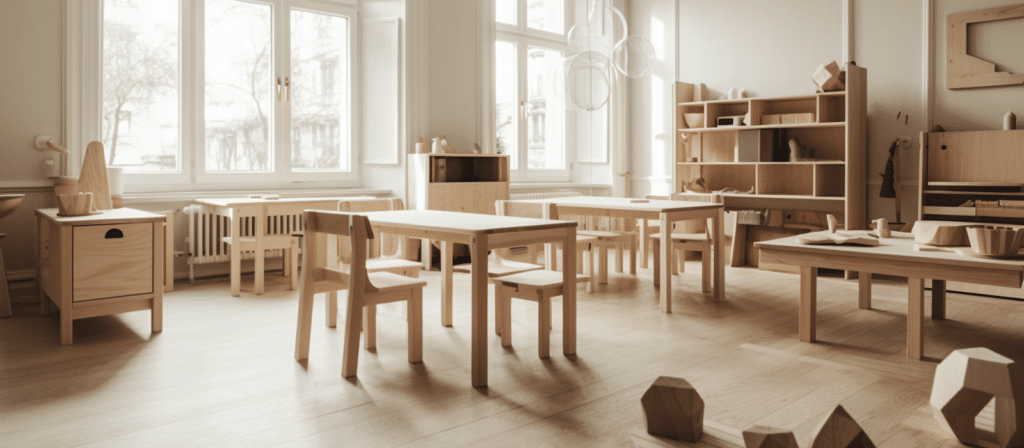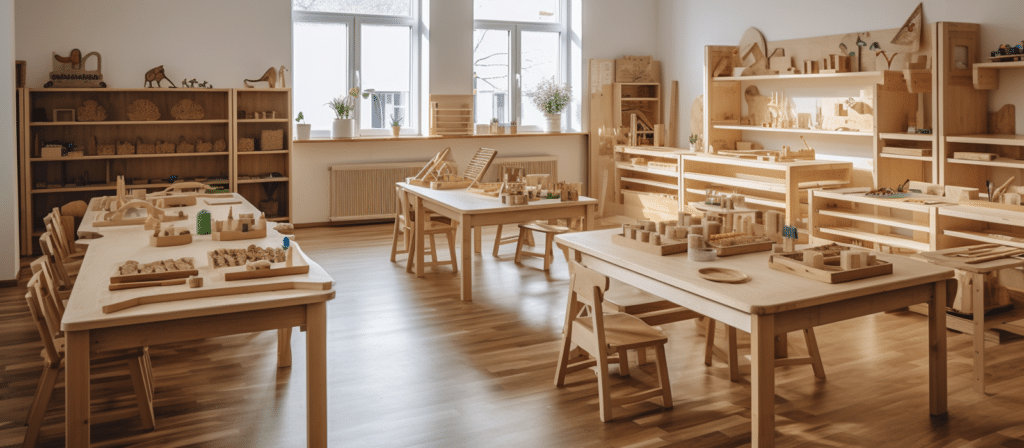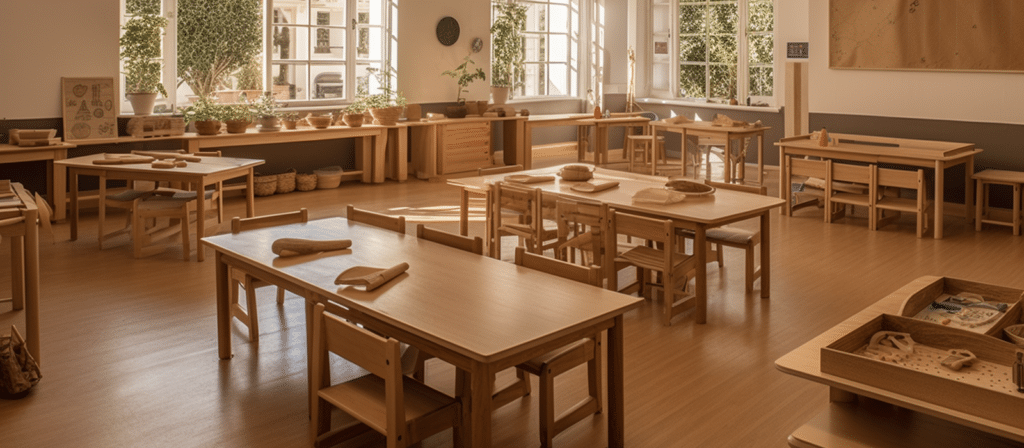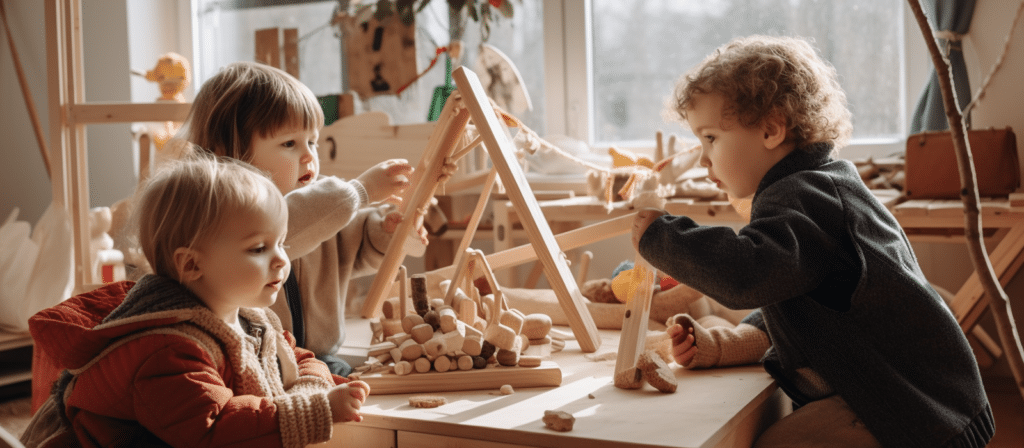Step into the realm of an early childhood classroom through the eyes of a child. The transition from the cozy embrace of home to an entirely novel environment unfolds. Picture the shifting hues of light, the chorus of unfamiliar sounds, and the myriad of new faces—a stark contrast to the world where she stirred from sleep, just hours before, nestled in her own bed.
As an educator of young hearts and minds, you wield the extraordinary ability to shape the emotional landscape of your classroom. The ambiance you craft, one that embraces children with a sense of belonging, safety, and warmth, stands as a pivotal pillar for fostering continuous emotional and social maturation. Only when children’s primal requisites for security, affection, and kinship are met can they earnestly embark on their journey of learning.
The Scaffold of Needs and the Symphony of Environment
Delving into Maslow’s Hierarchy of Needs offers profound insights into why the classroom environment holds paramount importance in nurturing children’s well-being and social triumphs. The bedrock requirement lies in the assurance that their physical needs will be catered to promptly and empathetically. Beyond this foundation, children crave emotional sanctuary and a supportive network. Ultimately, a deep-seated sense of belonging must flourish—where they feel embraced and treasured. Only then does the gateway to learning unfurl.
Pioneering a Landscape of Predictability
The orchestration of a harmonious start to each day can be orchestrated by meticulously sculpting the classroom to extend a heartfelt welcome to every child. Consider incorporating designated cubbies for stowing personal belongings, ensuring easy access when needed. Adorn various corners with visual testimonials of significant individuals in the children’s lives, allowing these familiar countenances to accompany them throughout the day. Yet, above all, invest the time to greet each child with a genuine embrace and a blank canvas—a fresh start unburdened by the challenges of yesterday.
In configuring the spatial arrangement of your classroom, recognize that it wields the potency to foster a welcoming haven just as compelling as your own nurturing presence. Elaborate furnishings are not prerequisites; the thoughtful organization of individual activity zones carries profound purpose. Make optimal use of available space and resources to underpin emotional and social development, ushering the spirit of learning.

One effective technique is maintaining a semblance of predictability in the classroom environment while infusing intermittent hints of novelty and change. For instance, envisage a library corner adorned with cozy nooks for solitary reading and larger seating for shared literary explorations among friends and alongside you. The foundational structure of the library remains unaltered day to day, yet the intrigue is invigorated by introducing diverse themes and spotlighting varied books across the year.
It’s imperative that the classroom’s physical setup resonates with the children it shelters. Equip the space with an abundance of toys and materials, ensuring a seamless experience where waiting for a turn never surpasses the limits of patience dictated by their age and developmental phase. Children can internalize the values of patience, sharing, and turn-taking only when assured that their turn shall materialize before exasperation takes hold.
Navigating Transitions with Finesse
Navigating the transition from one activity to another can be achieved by introducing cues that aid in upholding order. Label shelves and storage spots while deploying furniture to delineate distinct play zones. (Consider employing bookshelves to craft a dramatic play corner or employing easy-to-clean table mats to outline the art area for self-expression.)
Incorporating play as a consistent, anticipated element in the daily itinerary paves a path for nurturing emotional growth and sowing seeds of social development. Carve out generous stretches of uninterrupted, child-driven play, set apart from instances of instructor-guided learning. The zenith of creativity and the pursuit of novel experiences reside within the realm of play. Augment these moments by fashioning captivating invitations to play, stimulating ideas that might not have materialized otherwise. (Imagine, for instance, an arrangement where fire trucks encircle a fortress in the block area, beckoning children to ponder and explore the unfolding scenario.) To amplify this experience, leverage the classroom layout to offer diverse play options: solitude, camaraderie (with small groups of 2 to 5 children often working harmoniously), or collaboration with a teacher.

Harmonizing Dynamism and Tranquility
Early childhood classrooms pulsate with a vivacious energy, bustling with activity, conversation, and movement. Striving for equilibrium between opportunities for spirited, physical play and moments of serenity aids children in recalibrating. Sometimes, a bout of unbridled movement—be it dancing, stretching, or unstructured outdoor play—acts as the conduit for releasing pent-up energy, a cathartic release. In contrast, instances of reprieve from the ceaseless commotion become imperative, particularly during episodes of heightened emotions. Allocate sufficient spaces for regrouping—whether in solitude, with a companion, or by your side. These havens should stand apart from the bustling classroom, offering children the liberty to retreat when in need of solitude.
Nurturing Emotional Growth: The Human Ties That Bind
The number and positioning of educators and caregivers form a cornerstone of an enriching classroom atmosphere. Waiting for a coveted toy or activity can pose a challenge for children; awaiting your attention compounds this struggle. Small, contextually fitting group sizes and optimal adult-to-child ratios emerge as prerequisites. While financial considerations occasionally loom, maintaining an appropriate staff presence remains pivotal for nurturing the emotional and social evolution of young minds. Focused, attentive one-on-one interactions cultivate bonds, allowing children to bask in a sense of security and significance, thus laying the bedrock for learning.
While augmenting staff might not always be a feasible option, you can structure your day to curtail prolonged waits for your attention. Restricting instances of whole-class involvement and fashioning small, well-matched clusters (comprising two to five children) for instruction can prove invaluable. Permit other children to form their own play cliques and select activities, thus promoting autonomy. Recognize that certain children might necessitate greater attention and time, particularly if external stressors (a traveling parent, teething woes, or a newborn sibling) cloud their experience outside the classroom.
Remain within sight, arranging furniture to ensure easy access to you whenever a dose of reassurance or aid is sought. At times, a warm smile or a gesture of encouragement (a nod, a thumbs-up) holds the power to quell worries and alleviate frustration. Such a configuration also empowers you to observe children as they immerse themselves in work and play. As observations accumulate, a deeper connection with each child ensues, as you champion their friendships. Be prepared to reconfigure the classroom layout, daily timetable, and group dynamics as you foster an environment conducive to strong bonds. Encourage supportive staff and volunteers to assist with routine tasks, be it sorting papers or restocking art supplies, thus freeing you to channel your time and energy into nurturing robust relationships.

Championing Expressive Emotional Models
At the core of an emotionally nurturing classroom stands the teacher. Your demeanor, disposition, and adeptness wield immense influence. With no need for elaborate tools, you hold the power to forge a classroom that nurtures growth—socially, emotionally, and academically.
Educators attuned to social and emotional well-being prioritize relationships, viewing each child as a unique entity. They invest time in observation and forge bonds by actively engaging in play. When hurdles seem insurmountable, they join forces with children to navigate the course of problem-solving. Guiding play, they help children expand upon ideas, hone their communication skills, and experiment with fresh concepts when existing approaches fall short. Crafting and preserving friendships requires guidance; children seek your encouragement and guidance in cultivating positive connections.
Modeling healthy emotional expression emerges as a potent strategy in honing children’s nascent emotional skills. Children glean profound insights as you candidly and frequently articulate your feelings. When you confess, “The rain has left me disheartened! I had hoped for a nature walk,” children internalize the fact that intense emotions are natural and manageable. By labeling emotions in real-time, you endow children with a vocabulary to navigate their own feelings. “That was a boisterous cheer! You sound ecstatic!”
Your classroom ecosystem assumes a pivotal role in fostering children’s emotional and social prowess. Molding a welcoming, consistent, and developmentally suitable milieu; assigning prominence to play in the daily rhythm; arranging the classroom for easy child-teacher and child-child engagement; and infusing emotional exploration into the curriculum—these elements converge to cultivate skills that pave the way for triumph within the scholastic realm, at home, and in the wider expanse of the world.










